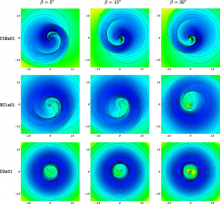
Abstract
In this paper we present 3D numerical relativity simulations of thick accretion disks around tilted Kerr black holes. We investigate the evolution of three different initial disk models with a range of initial black hole spin magnitudes and tilt angles. For all the disk-to-black hole mass ratios considered (0.044–0.16) we observe significant black hole precession and nutation during the evolution. This indicates that for such mass ratios, neglecting the self-gravity of the disks by evolving them in a fixed background black hole spacetime is not justified. We find that the two more massive models are unstable against the Papaloizou-Pringle (PP) instability and that those PP-unstable models remain unstable for all initial spins and tilt angles considered, showing that the development of the instability is a very robust feature of such PP-unstable disks. Our lightest model, which is the most astrophysically favorable outcome of mergers of binary compact objects, is stable. The tilt between the black hole spin and the disk is strongly modulated during the growth of the PP instability, causing a partial global realignment of black hole spin and disk angular momentum in the most massive model with constant specific angular momentum l. For the model with nonconstant l-profile we observe a long-lived m=1 nonaxisymmetric structure which shows strong oscillations of the tilt angle in the inner regions of the disk. This effect might be connected to the development of Kozai-Lidov oscillations. Our simulations also confirm earlier findings that the development of the PP instability causes the long-term emission of large amplitude gravitational waves, predominantly for the l=m=2 multipole mode. The imprint of the black hole (BH) precession on the gravitational waves from tilted BH-torus systems remains an interesting open issue that would require significantly longer simulations than those presented in this paper.